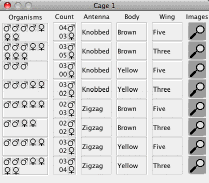| System requirements |
Operating System:
|
| Instructions for downloading, installing, and running VGLII |
VGLII Version 3.3.1 as of February 28, 2017  |
| Lab Manuals for VGLII |
|
The original version of VGLII was called "VGL". Many of the lab manuals were developed for VGL and have yet to be updated for VGLII. Fortunately, the user interfaces for VGL and VGLII are almost identical. However, the kinds of genetic models available in the different Problem files are not the same. Please check the
Documentation
page for details. Each of the lab manuals below were designed for particular version of VGL; if you want to use it with a different version, it may need slight revision. VGLII lab manuals will be available soon.
|
| Reporting bugs, etc. |
|
If you have installation questions or need help troubleshooting the Virtual Genetics Lab, Submit your bug reports to:
Feedback
.
|
| VGL Source code |
|
| VGLII Version History |
|